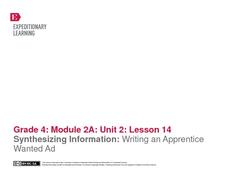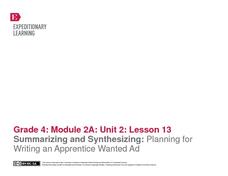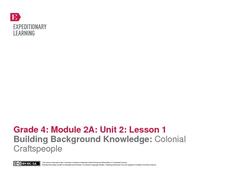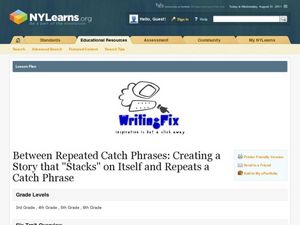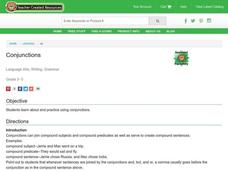EngageNY
Reading and Taking Notes on Colonial Trades
In the tenth instructional activity of this unit, young scholars learn to categorize information as they continue researching their colonial trade. During guided practice, the teacher models how to read informational text slowly while...
EngageNY
Mid-Unit 2 Assessment: Inferring About the Silversmith Trade in Colonial Times
The seventh lesson plan in this unit on colonial trade assesses fourth graders' ability to use details from an informational text to make inferences and create a piece of informative writing. The included assessment begins with learners...
EngageNY
End of Unit 2 Assessment: Working with Two Texts - Reading, Listening, Summarizing, and Synthesizing
As a summative assessment for this unit on colonial trade, fourth graders listen to and read informational texts in order to demonstrate their ability to take notes, write summaries, and draw connections. Young scholars first listen as...
EngageNY
Synthesizing Information: Writing an Apprentice Wanted Ad
Fourth graders view examples of help-wanted ads as they plan and create their own writing in the fourteenth instructional activity of this unit on colonial trade. The engagement of the class is captured when the teacher shares an actual...
EngageNY
Summarizing and Synthesizing: Planning for Writing an Apprentice Wanted Ad
In instructional activity 13 of this unit on colonial trade, young researchers learn about apprentices as they prepare to write help-wanted ads for the specific trade they have been researching. To begin, the class listens closely as the...
EngageNY
Building Background Knowledge: Colonial Craftspeople
In the first lesson plan of this unit on colonial trade, fourth graders gain background knowledge of different jobs performed by early colonists. The class begins with a slide show presentation that includes a variety of great...
EngageNY
Synthesizing Research: How Colonists Were Interdependent
Following the formative assessment of this unit, young scholars present the information they gathered on their specific colonial trade to the rest of the class. Working in groups, learners create posters describing the particular job...
Curated OER
Doo-Wop Pop
Doo-Wop Pop, by Roni Schotter is story that focuses on music and performing arts. Language arts activities include phonics, music, writing about dreams, poetry, and writing a letter are included in this literature guide. Furthermore...
Curated OER
The Amazing Maud Lewis
Students investigate cultural art from Canada by reading about Maud Lewis. In this Canadian history lesson plan, students identify the work of Lewis by visiting her magazine website. Students identify other heroes in Nova...
Curated OER
Creating a Story that "Stacks" on Itself and Repeats a Catch Phrase
Students explore language arts by reading a classic children's story in class. In this story structure lesson, students read the Judith Viorst book, Alexander and the Terrible, Horrible, No Good, Very Bad Day. Students discuss the...
Curated OER
Metaphors
Learners identify metaphors. In this figurative language lesson, students learn about metaphors and listen to various examples. Learners read a story and identify the metaphors present. Students complete a worksheet...
Curated OER
Conjunctions
Students examine the role of conjunctions in the English language. They discuss how conjunctions are used, observe a teacher demonstration, and complete various worksheets related to conjunctions.
Curated OER
How To Interpret a Newspaper Article
In this language arts worksheet, learners are asked to interpret a newspaper article. Students will decipher what phrases or catch words are used to capture the reader's attention.
Curated OER
Underlining or Italics and Quotation Marks
For this language arts worksheets learners will focus upon the correct usage of titles. Learners will focus on 14 sentences noting the correct way to punctuate the given proper nouns.
Curated OER
Free Verse Poetry
In this language arts worksheet, young scholars will focus on free verse poetry. Students will articulate a free verse poem about family, feelings, and a favorite place.
Curated OER
Dictionary Work
In this language arts worksheet, students investigate using a dictionary to determine the meanings of 8 words. Students find the words, write the page number and the definition and answer a yes/no question which shows their understanding...
Curated OER
Root Words
For this language arts worksheet students learn that root works are words from which other words are built. Students identify the root word in 6 words, then rearrange 6 scrambled words, putting the prefix, root word and suffix in order.
Curated OER
Comic Book Project
In this Language Arts worksheet, young scholars create a comic book. Students write an outline that includes experiences, family, friends, animals, and superheroes.
Curated OER
Cause And Effect Map
In this Language Arts worksheet, students create a cause and effect map. Students describe three causes, one event or situation, and three effects.
Curated OER
Student Resource Sheet-- Using Verbs in Writing
In this language arts worksheet, students explore the use of strong specific verbs in their writing. Students first read the information and look at the examples given. Students then brainstorm strong verbs to replace common words and...
Curated OER
The Daily Blab
In this language arts worksheet, students are provided a template for which to write a newspaper article. Students complete their own article and provide a picture/illustration to accompany what they have written.
Curated OER
Writing Conversation: Using Quotation Marks
In this language arts worksheet, young scholars learn to use quotation marks in written conversation. Students proofread 5 sentences and add the necessary punctuation. Then young scholars write a conversation, starting a new line and...
Curated OER
Wuzzles And Puzzles 9
In these language arts worksheets, students complete six "wuzzles." Using the clues provided, students decipher the sayings or short phrases of each word puzzle.
Curated OER
Homophones Activities 1-5
In this language arts worksheet, students discover that homophones are words that sound alike. Students complete 5 activities with homophones: matching words to pictures, completing sentences, explaining differences between words and...
Other popular searches
- English Language Arts Exam
- English Language Arts Games
- Deaf English Language Arts
- English Language Arts Music
- English Language Arts Heroes
- English Language Arts Skills
- Language Arts English
- English Language Arts Grade 3
- English Language Arts Poetry
- English Language Arts Rating=3
- English Language Arts Unit Sc
- Language Arts or English





